After taking the novice approach to Mega Man 2 — that is, starting in the left corner on the level select screen and working my way across and down — I think I have a better understanding of what “Airman ga taosenai” is all about. You start with Bubble Man, and it’s a kind of tough stage followed by a fairly straightforward boss; and then you move along to Air Man, which gives you a pretty manageable stage followed by an absolute bastard of a Robot Master.
Air Man’s stage feels different than anything that’s appeared so far in the Mega Man series. The platforms, like those in Bubble Man’s stage, tend to be fairly small and demand quite a bit of jumping. And you spend a lot of time hopping on interactive objects, as you did in Ice Man’s stage in the previous game. Yet the finished product doesn’t feel like either of those levels.
The stage begins with these massive oni-like robots, which you have to scramble across in order to advance. They’re completely stationary, fading into existence as you draw near. Despite remaining motionless in the sky, they require good timing. Their horns extend and quickly retract on a short cycle, allowing you just enough time to dash across and leap to the platform opposite if you make your initial jump the split second before the horns retract.
Note to the confused: The white hexagonal detail beneath its eyes is its nose, not its mouth. The mouth is the wide line across the bottommost portion of its base. It’s meant to resemble a Japanese ogre, not an octopus. You’re basically running across Lum’s dad’s head here.
If you stand too long on the oni, it will begin to disgorge smaller oni from the ports on the side of its head. Yes, Mega Man 2 enemies really like spitting out tinier versions of themselves, for some reason. The tiny oni fly upward and then begin slowly drifting toward Mega Man, homing in on him. They have little circular mouths that pulsate as they float, which doesn’t help resolve the ambiguity of the larger oni’s face, but I swear to god the round thing on the big guy is its nose. Seriously.
This is a solid start to the level — a test of timing with consequences for dawdling, but nothing too severe. As long as you take your time, there’s little danger of being knocked clear into the sky and dying here. But at the same time, the more you delay, the more hassles you have to contend with. So speed behooves you. Although, if you do have the Time Stopper here, you can freeze their horns and the mini-goblins alike.
Once you clear the first two oni, Mega Man 2 apologizes for that crappy floating platform sequence in Mega Man. This portion bears a strong resemblance to that infamously wretched chunk of Ice Man’s stage, but here it’s not a flaky, frustrating mess; it’s a clever, interesting, and challenging-in-a-fun-way test of timing and dexterity.
This expanse of sky is filled with five cloud platforms that rotate in a circular motion. You can jump onto the black portion peeping above the cloud portion — a small but clear hint of where it’s safe to land — and wait for your current platform to rotate back up to a high vantage point before hopping down to the next.
Ah, but you can see the challenge element in the screenshot above: Most of the platforms are already occupied. These robotic effigies of the thunder god Raiden ride the clouds around and toss lightning bolts at Mega Man. The bolts fly in a lazy arc that is only a threat if you happen to be below the enemy when he chucks it, but it’s easy in that situation to jump up and take a few shots at him first. Being struck by the lightning bolt can potentially knock you off a platform, so it’s wise to avoid giving these guys a chance to attack.
The rock-solid footing of the platforms and the destructibility of the threats attached to said platforms makes for a much more reasonable challenge than the aerial gauntlet in Ice Man’s stage. Just as well, because the easiest means to skip this portion altogether — the closest analog to the Magnet Beam — isn’t even accessible until after you defeat this level. Apology accepted, Capcom. Let’s never speak of those stupid gun platforms again.
One of the interesting details of this stage concerns the clouds in the foreground. Mega Man actually runs behind them at several points, which has the side effect of obscuring the action slightly. The cloud cover is very slight, blocking your view of Mega Man for just a brief instant — but generally instants where enemies appear and attack. You always get a clear view of the enemies’ approach, so there are no gotchas lurking behind cover. Instead, it simply demands an understanding of their movements and your control over Mega Man to avoid or destroy these briefly hidden foes.
At the end of the first half of the level, the screen stops scrolling and you run behind a cloud bank… only to drop down to the screen below. This is an admirable example of restraint. A lesser game might have put a few pits behind the clouds throughout the stage, forcing you to trial-and-error your way along. But Mega Man 2 continues the trend of smarter, more considerate, more ethical level design; with this game we’ve left behind the cruel days of hidden traps and untelegraphed dangers. Level designers use tricks sparingly and with ample forewarning. Mega Man 2 is an exceptionally well-designed game, and it is above all exceptionally fair (with maybe one or two small exceptions).
The final sequence takes you past multiple oni — this time consecutive to one another, forcing you to time your jumps from one to the next and essentially forcing you to wait as you hop from one demon to the next. Which is to say, increasing the likelihood that the mini-goblins will come after you while you wait, increasing the difficulty of the already tricky jumps. This is actually the first time in a single Mega Man stage we’ve seen a solid example of iterative design, of an early challenge teaching the ropes for a more complex variant of the task later in the level.
The chubby Air Man clone above brings about a second instance of Air Man’s stage building upon a previous challenge in short order. Earlier in the level, a series of birds flew past across the top of the screen, dropping eggs a short distance in front of Mega Man. Their behavior was remarkably similar to that of the hunchback-dropping eagles in the courtyard of Castlevania, except that the eggs don’t hop about madly upon landing; instead, they burst, unleashing a swarm of tiny birds that homes in on Mega Man.
The same hazard appears here as well, but this time with the added element of the fan guys, whose bodies generate a constant blast of air that pushes Mega Man back. The birds are tricky enough to evade or destroy as it is, but here you have to do it while fighting against backwards drag. The fanboys soak up several hits, and thanks to the weird relationship between scrolling and enemy spawns in Mega Man 2, letting them push you back far enough that they scroll off-screen causes them to essentially spawn anew. In other words, their hit points regenerate. So you need to balance the fight against the birds with the need to manage your distance from the junior Air Men, not letting them move too far out of your sight. It’s not hard, but it definitely demands a deft touch.
After all of this, Air Man can be incredibly tough for the newcomer. His attack consists of blasting six small tornadoes into the air, which spread across the room in one of several different patterns, hover momentarily, then drift forward off the screen. After doing this a few times, he leaps across the room and repeats the process.
The sheer number of projectiles he emits, and their odd way of moving, can be a little overwhelming. To make matters worse, the tornadoes block your own shots; they are invincible. You can’t simply stand and pump Air Man full of bullets, because his projectiles will deflect them harmlessly. The trick, of course, is to slip past his tornadoes and stand in close, pouring fire into Air Man from close range. Even this isn’t a slam dunk strategy, as Air Man is constantly blasting a stream of air that pushes Mega Man away (hence the movement of his little tornadoes). But if you can get in close — and veteran players will find leaping his projectiles somewhat similar to avoiding the chunks flying across the room during Mega Man‘s Yellow Devil battle — your basic attacks will outpace the damage he can cause.
The trick, in other words, is to be aggressive. Even Air Man’s weakness — the Leaf Shield — requires you to move in close. The constant flood of tornadoes makes it essentially impossible to get a clear shot at Air Man from across the room; used as a projectile, the Leaf Shield has such a wide spread that it will inevitably strike a whirlwind and drift harmlessly to the ground. You need to close the gap in order to make your Leaf Shield strikes count.
And yes, Air Man’s stage offers some broad hints for the utility of the Leaf Shield against the boss. Those birds that drop the baby-making eggs are rendered almost preposterously harmless by the Leaf Shield; not only will the flock of babies explode harmlessly against the shield, they’ll usually drop a ton of power-ups in the process. They have a curious tendency to drop a huge number of 1UPs, for some reason… the only downside being that so many power-ups drop at once that most of them vanish before hitting the ground. There’s something a little heartbreaking about seeing a 1UP materialize then evaporate a split second later.
Air Man is also vulnerable to the maxed-out Atomic Fire, though the Leaf Shied caveat applies: The full Atomic Fire takes the form of a huge projectile that is easily blocked by the tornadoes.
Defeating Air Man doesn’t just earn you the Air Shooter, it also gets you equipped with Item-2. The Items are a trio of tools that take the place of the Magnet Beam, filling similar roles. But they have the advantage of being unmissable — you can’t reach Wily’s lair without the requisite Items in hand, because you gain them automatically after completing certain Robot Master stages. Again, apology accepted.
Item-2 is a small sled that flies forward horizontally across the screen until it runs out of juice. Like the way any sane person uses the Magnet Beam in Ice Man’s stage, this helps you traverse wide horizontal expanses… which would have made it really handy in Air Man’s stage. Oh well! It has plenty of other uses, though. And since it flies straight forward, it doesn’t have the Magnet Beam’s tendency to force you to rise as you advance forward. A superior choice all around.
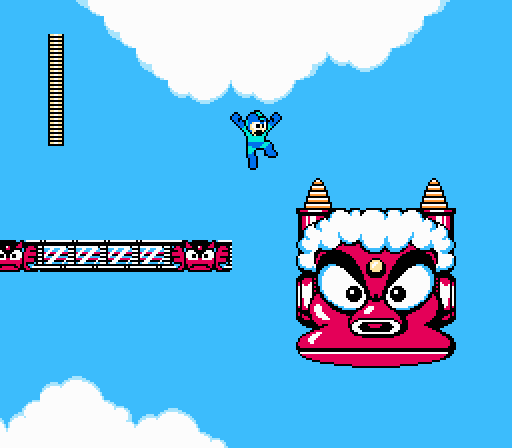
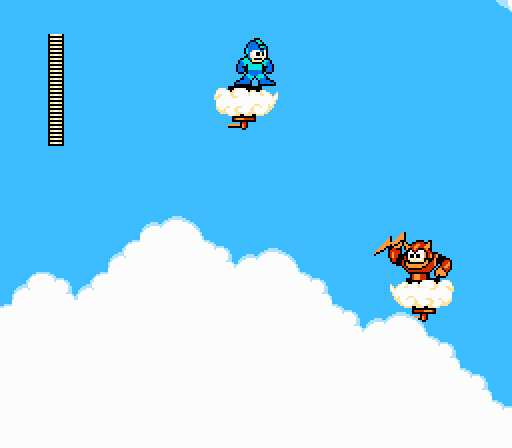
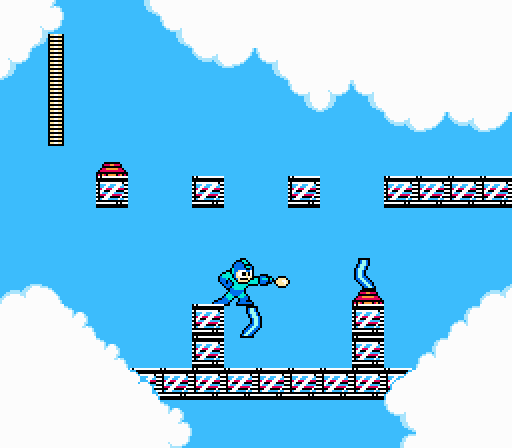
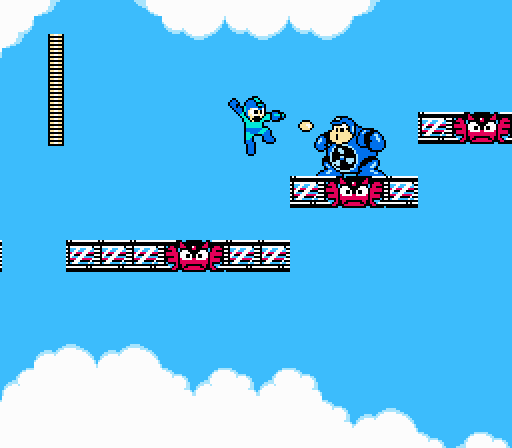
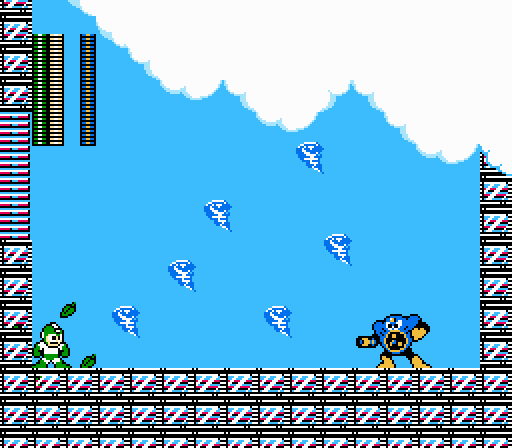
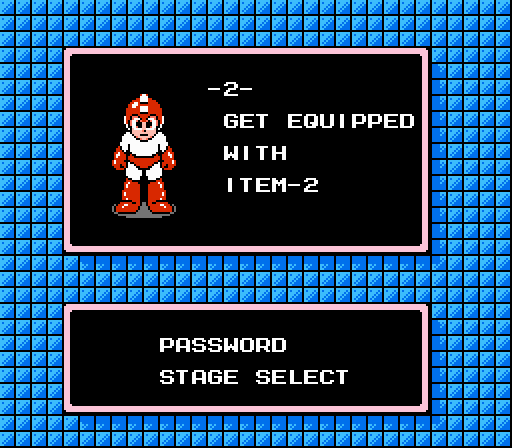
Air Man’s is one of the best levels to me. Also because of the music, which is gorgeous. The only thing I don’t like (and which is pretty unfair) is when you have to jump over a gap with a cloud above, and that thrice-accursed bird drops an egg on your head.
I never found Air Man that hard, though he certainly isn’t among the easiest.
And as a curious fact: in the European (at least) MMII, there was a step-by-step walkthrough for Air Man’s stage in the instruction booklet.
Let’s be honest, most of the music in MM2 is amazing.
Something I remember about the stage is where you have to jump between two of those oni and it’s possible to spawn the second one at a time that makes it very daunting if not impossible for a novice to shoot the little ones and then jump between the horns on both of the big ones.
And, uh, I can see it when it’s pointed out to me, but I always saw those oni noses as mouths. TIL!
I’m guessing those oni-like robots are meant to be Fuujin, which are sometimes depicted as twin-horned oni. That would make them a good match for the cloud-riding Raiden, as the two are often together.
I think the American instruction book also had a walkthrough for Airman’s stage, along with the suggestion that it’s the easiest stage and should be completed first. But I always had problems with this stage when I was little, and usually picked Woodman or Heatman first. Call me crazy, but I actually like those disappearing block puzzles.
As a kid, I went after the Metal Blade first, but I quickly realised that the real prize from Air Man wasn’t the Air Shooter - it was Item 2. It not only works as the jet skateboard it was intended as, but it’s a quasi-Magnet-Beam as well since you can use it to create a temporary step in lot of situations. The second E-Tank in Metal Man’s stage is the first example of this, where you don’t need it for more than a second.
(I had a big rant about how Parish was ignoring the biggest change to Mega Man’s mechanics in eliminating the ability to re-visit stages, but I presume that’ll come up again later)
I wouldn’t call that a mechanical change; I would call it a structural change.
Let’s compromise and call it strategic, because it certainly makes the player think about conserving resources more than he would if they could go back and scoop up excess E-tanks.
I always have to concentrate really hard- like I’m looking at a Magic Eye poster or something- when I want to make those giant heads look like an ogre instead of an octopus.
I had never seen them as octopi until reading this article. Probably the lack of tentacles. If you do see an octopus, what does the mouth look like to you? (the real mouth, not the nose)
I don’t rightly know- some kind of platform segment that’s not quite part of the robotic “face”? Perhaps it’s the fact that the line for the mouth goes ALL the way through the lower part of the face which makes it so misleading.
“Octopus” wasn’t exactly how I thought of it, precisely; I didn’t really think of it as any kind of identifiable animal, just a weird-looking creature. I borrowed Jeremy’s “ogre rather than octopus” phrasing because it’s more artful than saying “I thought the big bulbous thing in the middle was his mouth rather than his nose.”
I said octopus because that’s kind of how Japan draws cartoon octopi, vis-a-vis http://gradius.wikia.com/wiki/Takosuke
Yeah. It makes sense when you describe it that way, but I didn’t think of it as an octopus beforehand. Just sort of a weird robot face… thing.
Also, it feels like this has been brought up on the site before. Was it not the subject of some discussion on a previous post, or maybe one of the many Talking Time threads I lurked on?
Capcom actually recommends Airman as the first stage to tackle in the manual - so when I played as a kid, I always chose Airman first (I was a child who tended toward an overabundance of caution). Which is why Airman wo Taosenai has always confused me a bit, because I can blitz him pretty easily. Now QUICKMAN…
Airman’s kind of a dud of a boss, though. I’ve always thought attacks with no ability to dodge, counter, or prevent are kinda bullshitty, and a few of the tornado formations are really not avoidable - ironically, this makes him a pretty good boss in Megaman 3, where you can actually avoid everything with well-timed slides.
He’s one of the only bosses who goes down in a battle of pure attrition. Run toward him, try futilely to avoid some of the tornadoes, keep firing. Even Metal Man requires more finesse. For that, I’d say he’s tied with Flash Man as the easiest boss in the game.